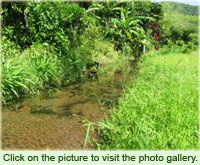
The main components of a lo‘i are described below.
Kahawai – The kahawai or stream is a vital component of a lo‘i. This is where  the water for the lo‘i would come from. Because of its importance, most lo‘i are built near kahawai. Within the ahupua‘a, the kahawai would run from mountain to sea. In some, the kahawai would empty out in a loko i‘a (fishpond). The advantages of this is that as the water flows down the kahawai and especially in and out of a lo‘i, it collects nutrients that are vital and beneficial for the organisms living in the loko i‘a, which in turn helps the production of i‘a (fish).
the water for the lo‘i would come from. Because of its importance, most lo‘i are built near kahawai. Within the ahupua‘a, the kahawai would run from mountain to sea. In some, the kahawai would empty out in a loko i‘a (fishpond). The advantages of this is that as the water flows down the kahawai and especially in and out of a lo‘i, it collects nutrients that are vital and beneficial for the organisms living in the loko i‘a, which in turn helps the production of i‘a (fish).
Po‘owai - Another vital component for a lo‘i is the po‘owai. Literally translated po‘owai means the “water head or source.” The method in which to divert enough water for the lo‘i from the kahawai to the lo‘i is by building a damn of rocks that will move some of that water from the kahawai into the ‘auwai (ditch). One reason why rocks were used is so that during times of heavy rain and the kahawai was overflowing, the rock damn would collapse preventing heavy flooding in the lo‘i, by keeping majority of the water in the kahawai.

‘Auwai – The ‘auwai is a man-made irrigation ditch that carries the water from the kahawai to lo‘i and then back to the kahawai. In areas in which there were more than one lo‘i, ‘auwai were built to move the water from lo‘i to lo‘i.
Kuāuna – In the process of building a lo‘i, the land where the lo‘i was to be built was dug up and the dirt thrown on the outer most boundary line of the lo‘i. Once the dirt was piled on the bank to a level high enough to hold the water in, the sides of the embankments or kuāuna that were to face inward were stamped down with feet until it was firm and the edges and lines were straight.